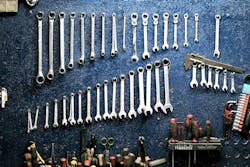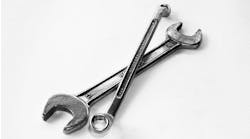Nov. 5, 2020—Cecil Bullard, CEO at the Institute for Automotive Business Excellence, presented a seminar on Diagnosing and Repairing Your Business for the Automotive Aftermarket Products Expo (AAPEX) being presented online this week.
Bullard addressed myths about running an automotive repair shop.
Myth: If I have enough cars, I’ll make enough money.
Car count is not an indicator of success, he said. If you have too many cars and are not selling extra products, it is difficult to make a profit.
You may be doing things to cars that take time but you’re not charging the customer for it. Look into whether you’re spending time on cars not related to the repair requested. And look at what type of repair you are performing. Is it a low paying job such as an oil change, or a high paying job with higher margins and more profit?
“You can make more money with the pen than you can with every tool in your toolbox,” Bullard noted, meaning examine every car to find opportunities for performing extra needed services..
Look at increasing your labor rate, too, your customer will not notice, he said.
Myth: Gross profit dollars per hour is the most important number.
Gross margin is always the most important number in business.
Myth: I don’t need to track the numbers. I can see what’s in the checkbook.
The auto business is a cash flow business, and what’s in your checkbook is not necessarily your profit, he pointed out. Your checkbook reflects the amount of cash you have.
You need to understand your numbers and run your business by the numbers or you will lose hundreds of thousands of dollars throughout your career. “Not knowing your numbers is like trying to diagnose a modern car using only your wits and a test light.”
Myth: Customers won’t love me if I am more expensive than the guy down the street.
That may apply to about 2% of your customers, Bullard said. Most people will pay for convenience. Lots of things go into deciding where to go for auto repair, and the price you charge is only a deciding factor for a small percentage of your customers.
Don’t set your prices using the guy down the street for comparison.
Myth: I don’t have time or money for training.
“Ignorance is much more expensive than training,” Bullard stressed. Shops with owners who have had education consistently earn substantially more.
Myth: The only way to make money in this industry is to do something dishonest.
You cannot sell things to customers that they do not need. You can make money doing what’s right. Running your business correctly will make you profitable, not stealing from your customers.
Myth: Employees should know what to do and do it.
Employees not trained and managed will never do the job the way you want it done. “Common sense is a myth,” said Bullard.
Myth: If I hold my employees accountable, I will lose them.
Employees who have clear goals and boundaries and are held accountable to clear company goals and policies are happier because they know the rules and they know you care about them and appreciate them.
Myth: You can’t make any real money if you own a shop. It is too hard.
There are many shop owners who achieve 20% profit and work fewer than 40 hours a week without ripping off their customers. You can earn a great living and have time for your family, Bullard said.
Bullard also noted there are tools you need to be successful:
-
A good, timely, accurate profit and loss statement with monthly management numbers, car counts, labor rates, etc.
-
A good balancing/projection spreadsheet.
-
Daily and weekly management numbers.
-
A solid understanding of the numbers and what they mean.
Important numbers include:
-
Gross profit/sales
-
Gross profit dollars and margins
-
Parts margins
-
Labor margins
-
Opportunities
-
Average repair order
-
Effective/actual labor rate
-
Car count
-
Average productivity/efficiency of techs
-
Break even point
-
Desired profit
-
Labor inventory
-
Fixed expenses
-
Net profit
-
Key performance indicators
Have continuous communication with those working in your shop, Bullard stressed. Have department meetings, set goals, create processes and get agreements from your staff -- those who are doing the work. Tell them what you expect and let them know they need to be responsible.
You need to:
-
Decide what you want out of your business.
-
Write down your goals and decide what you’ll do to reach your goals. Work hard? Get education?
-
Strategize -- who can help you, what is your goal, who will be responsible for what, and when is it supposed to be done.
-
Do the work -- and measure and manage results.
-
Review and assess numbers weekly and monthly.
-
Reset your target or re-strategize.
You also need to understand your customers and target the right ones. Bullard figures it costs $67 to market to and gain each new customer.
Success in business is defined as hitting your goals.



